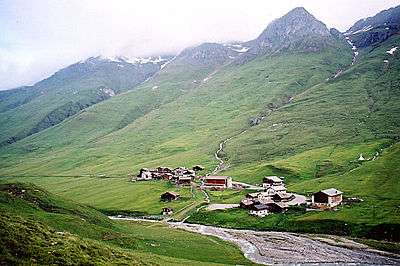Juf

Juf is a village in the municipality of Avers in the canton of Graubünden, Switzerland. At 2,126 metres (6,975 ft) above sea level, it is the highest village with permanent residents in Switzerland and in Europe.[1] Juf has a population of about 24 inhabitants divided over 6 families in a concentrated settlement. They were 20 in 1991 and 30 in 2001. The first inhabitants were immigrant Walser who arrived in 1292.
Heating

Juf differs from settlements in lower valleys in having no trees. Wood was transported for building houses and stables, but dried manure from the inhabitant's animals was burned for a long time instead of wood. Some storages at the sun front of their stables are still visible today. Dried manure contains a lot of energy, produces hardly any smoke and is used all around the globe in areas that lack wood.
Transport
Despite its remote location, Juf can be reached by public transport eight times a day all year round, as all post buses running to the high valley of Avers go on to the very end of the road at Juf.[2] It is nevertheless a very remote valley, its infrastructure designed primarily to encourage tourism (two platter lifts for skiing in winter at nearby Juppa), and has been spared the technical installations, such as power lines or tourist resorts, which might otherwise ruin its "pristine beauty".
Note
Another source gives the title of Europe's highest village to Li Baita, a part of Trepalle, Italy.[3] Just above Juf is an old farmhouse, the Platten-hof, birthplace of writer Johann Rudolf Stoffel. This is considered the highest farmhouse in Europe.[4]
See also
References
- ↑ Mountain records swissworld.org
- ↑ Graubünden Sightseeing, Switzerland; how to reach Juf (official Graubünden tourist board) Archived 2011-07-06 at the Wayback Machine.
- ↑ Livigno Tourist Office Archived 2012-09-09 at Archive.is www.livigno.eu
- ↑ Meissner, Hans Otto (1963). Unknown Europe. trans. Florence and Isabel McHugh. London and Glasgow: Blackie & Sons. pp. 156–157.
- Juf in German, French and Italian in the online Historical Dictionary of Switzerland.
External links
| Wikimedia Commons has media related to Juf. |
- Village visit is elevating experience swissworld.org